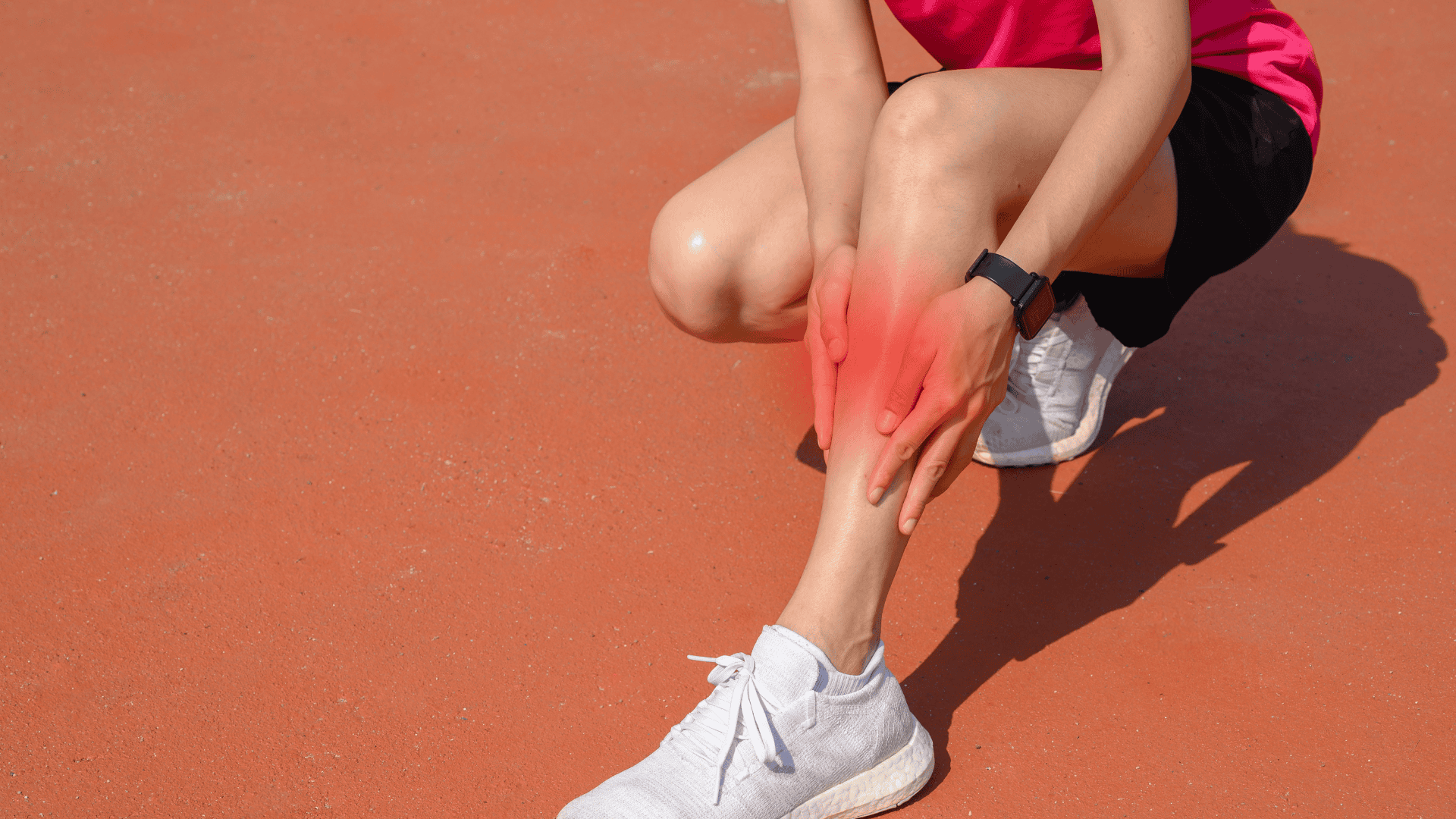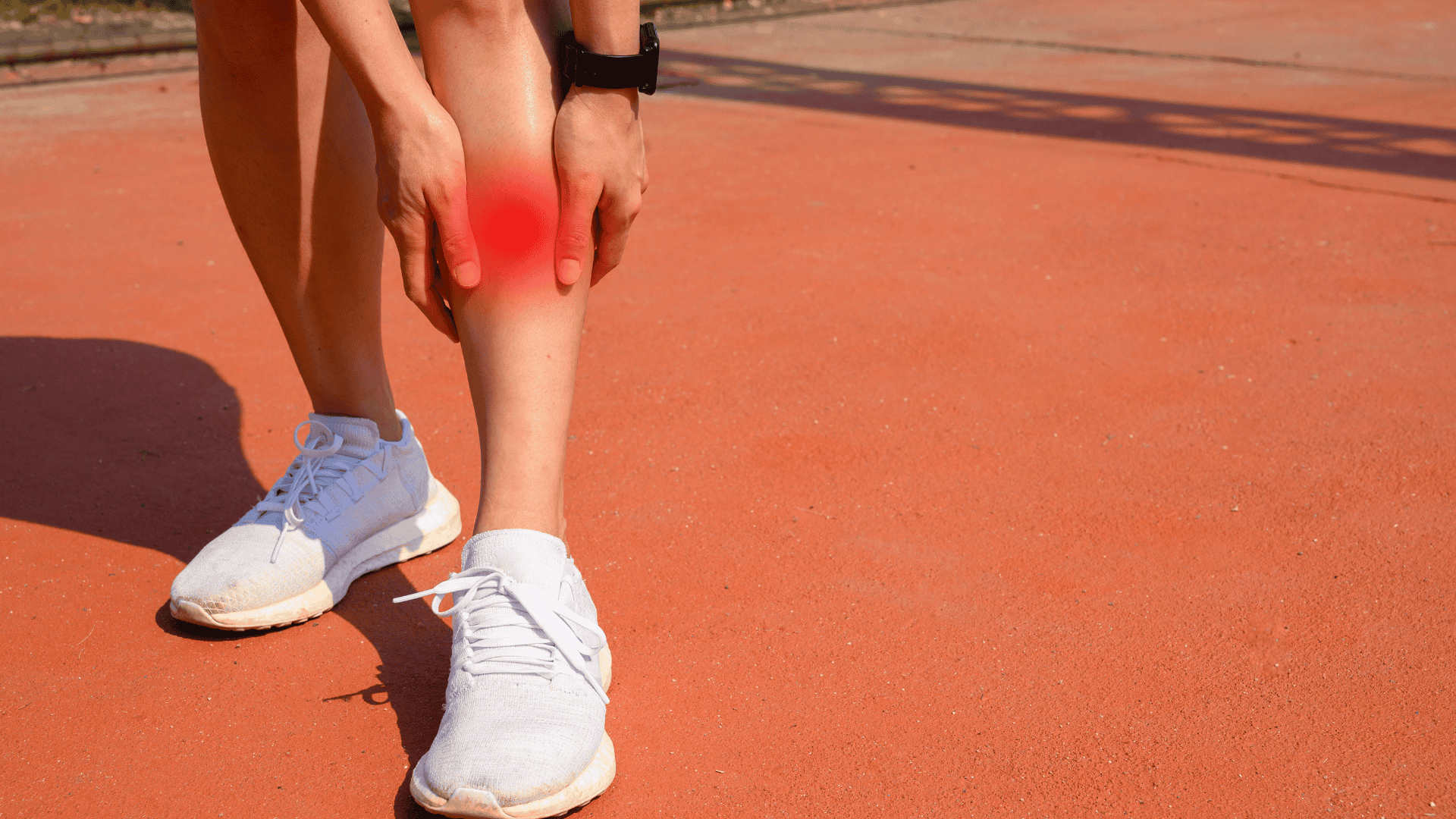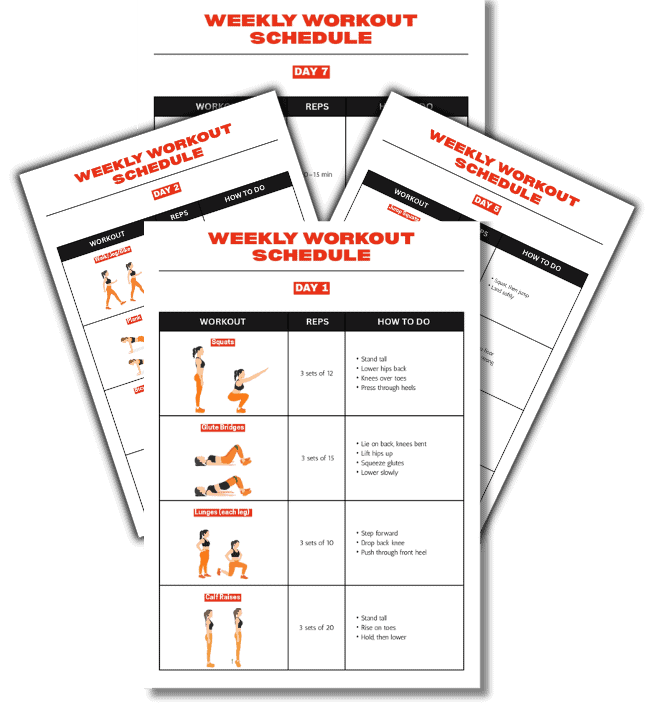Ever take a few steps into a workout and get that tight, sharp ache down the front of your lower legs?
Yep! shin splints.
They show up fast and make everything harder. One minute you’re moving fine, then suddenly you’re slowing down, limping, or stopping altogether.
This usually happens when your legs aren’t ready for the impact. It can come from overtraining, skipping warm-ups, poor shoes, or jumping into a new routine too quickly.
But with the right stretches, you can loosen up those tight muscles and give your legs the support they need. Over time, this can help ease the pain and lower your chances of shin splints coming back.
In this blog post, you’ll learn the exact stretches that work, when to do them, and what else you can do to keep your lower legs moving pain-free.
What Are Shin Splints and Why Do They Happen?

Shin splints usually show up as a sharp or aching pain along the front of your lower legs. It often starts when you move more than your body’s ready for, like during a tough workout, a long walk, or even after just a few minutes of jogging.
Some people describe it as a burning feeling. Others say it feels like pressure right on the bone.
This happens when the muscles around your shin bone get OVERWORKED. That can come from doing too much too soon, skipping warm-ups, running on hard surfaces, or wearing shoes that don’t offer enough support.
Shin splints are common in runners, walkers, dancers, and anyone who jumps into a new routine too fast. If you’ve ever gone from “I should work out” to sprinting three miles on day one (no judgment), you’ve probably felt it.
The muscles in your lower legs just need a little care. When they’re tight, tired, or overloaded, they start to push back. (and not in a fun way)
But you’re not stuck with shin splints forever. In fact, one of the easiest ways to start feeling better is by adding the right stretches into your routine.
But How Does Stretching Help?
Stretching isn’t just an extra step; it’s one of the easiest ways to take pressure off your shins and help your legs move better.
Think of it as your muscles’ way of warming up for the job ahead.
When your muscles are tight, they tug on the bones they’re attached to. In the case of shin splints, that tugging happens along your shin bone. The more you walk, run, or jump with tight legs, the more that pulling adds up. (and yep, that’s when the pain kicks in)
Stretching helps loosen things up. It gives your muscles more length to work with, which means less tension, less strain, and less pain.
So why does it matter? Because stretching:
- Makes it easier to move without that sharp, annoying ache
- Helps stop shin splints from coming back
- Lowers your risk of other injuries (because everything’s working better)
And let’s be honest. It just feels good.
If your goal is happy, pain-free shins, stretching isn’t optional…
It SHOULD be part of the plan.
6 Shin Splints Stretches to Relieve Pain at Home
If your shins are tight, sore, or just plain annoyed, these stretches can help. You can do them at home, at the gym, or even while watching TV. Just go slow, breathe through each stretch, and don’t bounce.
Let your muscles ease into it.
1. Standing Calf Stretch
Your calf muscles connect to your shins, so let’s start here.
How to do it:
- Stand facing a wall.
- Put both hands on the wall for balance.
- Step one foot back. Keep that heel flat on the floor.
- Bend your front knee just a little, so you feel a gentle stretch in your back calf.
- Hold for 20 to 30 seconds.
- Switch sides.
Tip: If your heel wants to pop up, gently press it down. Pretend you’re squishing a bug under your shoe.
2. Seated Shin Stretch
This one wakes up the front of your lower legs.
How to do it:
- Sit on your knees (like you’re about to start a picnic on the floor).
- Point your toes straight back behind you.
- Slowly sit your bottom back toward your heels.
- You should feel a stretch along your shins.
- Hold for 20 seconds.
- Relax and repeat if it feels good.
3. Toe Taps
These look a little silly, but they work. (promise!)
How to do it:
- Sit in a chair with both feet flat on the ground.
- Lift your toes up toward the ceiling, then tap them back down.
- Do this 20 to 30 times in a row.
4. Heel Walks
A stretch and a mini workout in one.
How to do it:
- Stand up tall.
- Lift your toes so you’re balancing on your heels.
- Walk forward for about 30 seconds, staying on your heels the whole time.
- Rest, then try it again.
You might look a little like a penguin, but your shins will love it!
5. Soleus Stretch
This hits the deeper calf muscle (yep, there’s more than one).
How to do it:
- Stand facing a wall with both hands on the wall.
- Step one foot back, but this time bend both knees.
- Keep your back heel down.
- Lean forward gently until you feel a stretch in your lower calf and above your ankle.
- Hold for 20 seconds.
- Switch legs.
6. Tibialis Anterior Stretch
Let’s give the front of your shin some love.
How to do it:
- Stand tall.
- Put one foot a little behind you, keeping the top of your toes pressed against the floor.
- Gently press down until you feel a light stretch along your shin.
- Hold for 15 to 20 seconds, then switch legs.
Bonus: Foam Rolling
Not really a stretch, but it helps your muscles chill out.
How to do it:
- Sit on the floor and place a foam roller under your calf.
- Roll slowly from your ankle to the back of your knee.
- If you find a sore spot, pause there and breathe.
- Roll each leg for about 1 minute.
How to Build Your Shin Splints Stretch Routine
Here’s how to put it all together:
- Pick 3 to 5 of these moves.
- Hold each stretch for 20 to 30 seconds.
- Repeat each one 1 to 2 times.
- Try to stretch at least once a day, especially after you exercise.
Your shins work hard for you so, show them some love! With these stretches, you’ll be well on your way to feeling better.
Smart Stretching Tips That Actually Help, Not Hurt
Stretching may seem simple, but doing it the right way makes a big difference, especially when your shins are already irritated.
These tips will help you get the most out of every stretch without making things worse.
Warm Up First
Stretching cold muscles doesn’t do much. In fact, it can make tight spots feel even tighter.
Before you stretch, get your blood flowing with 2 to 3 minutes of light movement. Walk around the room, do ankle circles, or march in place.
That’s all it takes to wake up your legs.
Hold Long Enough to Make It Count
Each stretch should last at least 20 to 30 seconds. That gives your muscles time to relax. Don’t rush through it. Take a few slow breaths while you hold.
And if a stretch feels especially good, you can hold it up to 40 seconds, but if it starts to pinch or burn, ease up right away.
Make It a Daily Thing
Stretching once a week won’t cut it. Aim to stretch every day, especially if your legs feel stiff or you’ve been working out more than usual. The best time to stretch is right after exercise, when your muscles are still warm.
Consistent stretching helps prevent tightness and keeps shin pain from creeping back in.
Pay Attention to Your Body
A good stretch should feel like a gentle pull, not pain.
Sharpness, pinching, or swelling is your body’s way of saying something’s off. If that happens, stop and give it a break. And if something still doesn’t feel right after a day or two, it’s okay to check in with your doctor.
Your body gives you signals. Don’t ignore them.
4 Tips to Prevent Shin Splints from Coming Back
Shin splints are annoying, but the good news is that most of the time, they can be avoided. These four tips will help you keep your lower legs healthy and pain-free as you stay active.
1. Wear Supportive Shoes That Still Have Life in Them

Shoes that are too old, too flat, or just not made for movement can add stress to your shins.
Make sure your shoes fit well, have good arch and heel support, and aren’t worn down. If they’re starting to feel flat or the tread is fading, it’s time for a new pair.
Most running or walking shoes last around 6 to 12 months with regular use.
2. Increase Your Workouts Gradually
Going from short walks to long runs overnight can overload your lower legs fast.
Instead, build up slowly. Add time, distance, or intensity in small steps so your muscles and joints can keep up without getting overworked.
3. Add Variety to Your Weekly Routine

Doing the same type of workout every day can put extra strain on the same muscles. Try mixing in other activities like biking, swimming, or yoga.
These give your legs a break while still keeping your body active.
4. Avoid Hard Surfaces When You Can
Running or jumping on concrete makes shin splints worse. Choose softer ground like grass, dirt trails, or a treadmill when possible. If you need to be on hard floors, make sure your shoes have solid cushioning, and keep up with your stretching.
Sticking to these habits can help you stay active without dealing with shin pain over and over again.
When to Rest and See a Doctor

Most of the time, shin splints just mean your legs need a little break. But sometimes, the pain could be a sign of something more serious.
Here’s how to tell what your body needs and when to ask for help.
When to See a Doctor
If you notice any of the signs below, don’t try to push through them:
- Sharp or stabbing pain that doesn’t go away, even with rest
- Swelling that doesn’t calm down or keeps getting worse
- Bruising on your shins that showed up out of nowhere
- Trouble walking, standing, or moving your foot up and down
These can be signs of a stress fracture or another injury. In that case, it’s best to call your doctor and get checked out.
How to Rest and Recover at Home
If your shin splints are mild, rest and self-care can usually help. Start with this:
- Take a break from whatever caused the pain. Try low-impact options like swimming or biking instead.
- Use ice packs for 10 to 15 minutes, a few times a day.
- Elevate your legs when possible. It helps with swelling and gives your muscles a break.
- Keep doing gentle shin stretches, but stop if anything feels worse.
- If needed, use over-the-counter pain relief like ibuprofen. Just follow the directions on the label.
Once the pain fades, ease back into movement. Start with short, light sessions, and go slow. If the pain returns, pause again. Resting now can save you from bigger problems later.
What to Remember About Shin Splints Stretches
Shin splints aren’t fun, but they’re fixable.
With the right stretches, supportive shoes, and a little more care in your routine, you can keep that pain from coming back and help your legs feel strong again.
It’s not just about pushing through. It’s about working smarter. When you stretch daily, warm up before workouts, and switch up your routine, you give your muscles what they need to move better and recover faster.
Here’s your quick recap:
- Stretch every day, especially after you move
- Warm up before workouts
- Wear shoes that still have support
- Don’t ignore pain, rest when you need to
- Mix in low-impact workouts to reduce stress on your shins
These small habits add up. Your shins will move better, feel better, and stay ready for whatever’s next.
So go ahead—get up, stretch it out, and take care of those legs. They’ve got places to go, and so do YOU.
Stay Active Without the Pain

Shin splints can make even the simplest workouts feel impossible—but they don’t have to hold you back.
What you need is a plan that keeps your body balanced and helps you train without setbacks.
That’s exactly what the Free Weekly Workout Schedule delivers.
It gives you a step-by-step weekly framework that blends strength, stretching, and recovery, so your lower legs stay supported while the rest of your body gets stronger.
No more guessing which workouts to pair together or worrying about pushing too hard, just a simple structure that keeps you consistent and pain-free.
Frequently Asked Questions (FAQ)
1. Can you stretch away shin splints?
Stretching can help a lot, but it doesn’t make shin splints disappear overnight. It helps your muscles relax and takes some stress off your shins. If you stretch every day and rest when you need to, your pain should start to fade.
2. How long until you feel better?
Most people feel better in about one to three weeks, if they take care of their legs and don’t push too hard. If you try to go back too soon, the pain can come back. Give your shins time to heal. Slow and steady wins this race!
3. Can you exercise with shin splints?
Yes, but choose activities that don’t make your shins hurt. Swimming, biking, or gentle yoga are all good options while you heal. Skip high-impact moves like running or jumping until your pain is gone.
4. What if my shin splints keep coming back?
If you keep getting shin splints, check your shoes, your training plan, and your workout surfaces. You might be doing too much, too soon, or your shoes might need to be replaced. Make sure you stretch often and change up your workouts to give your legs a break.
5. When should I call a doctor about shin splints?
Call a doctor if your pain is sharp, lasts longer than a few weeks, or if you see swelling and bruising that doesn’t go away. It’s better to check early than to risk a bigger injury later on.










